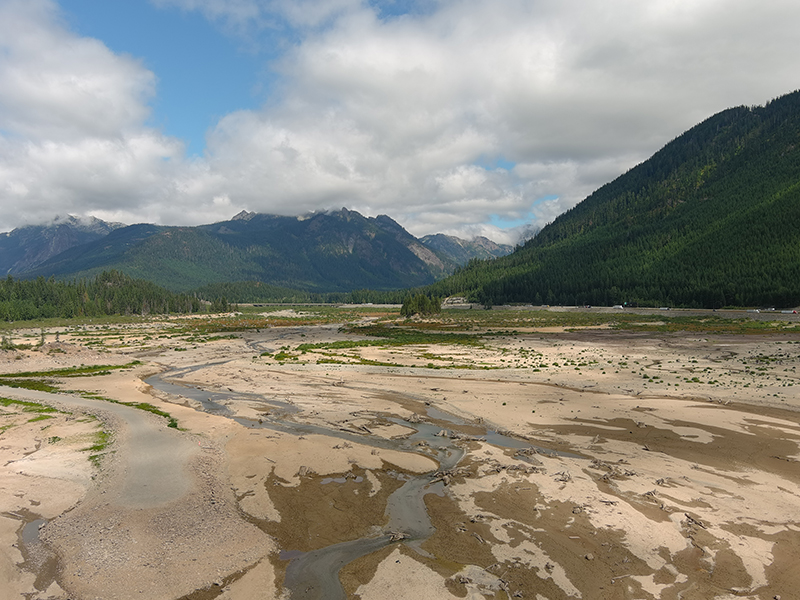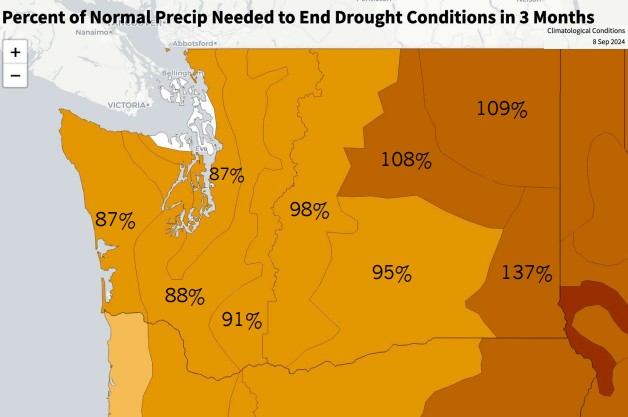
The water year begins Oct. 1 and ends Sept. 30. Three months before the calendar year changes, hydrologists and other water scientists mark the start of the new water year. Starting the water year in October ensures annual precipitation measurements reflect winter snow accumulation and summer rainfall.
Drought
This year, like many years in recent history, was charactered by low water supply. Six of the last ten years have included some level of drought in Washington. In 2024 low snowpack and forecasts for a dry and warm spring and summer spurred Ecology to declare a statewide drought on April 16 with limited exceptions for Seattle, Everett and Tacoma metro areas.
According to the most recent meeting of the Water Supply Availability Committee, the water year through August was warmer than normal with near-normal to slightly below normal precipitation. While this summer was warm compared to historical averages, it was cooler than the last three summers. Summer precipitation deficits range between one and three inches in eastern Washington while precipitation was near normal to above west of the Cascade Mountains. Over the next three months, the amount of precipitation needed to make up for existing deficits and end drought conditions varies from 87% of normal on the Olympic Peninsula to 137% of normal in the southeast portion of the state.
This map illustrates the percent of normal precipitation needed to exit drought conditions in three months
The water year is closing out with some improvements to drought conditions thanks to rain showers and cooler weather across the state. A weak La Niña is likely to develop in late Fall.
During a drought, Ecology has the ability to process emergency water right transfers and distribute emergency drought grants to public entities.
Drought Response Grants
We have received 16 total applications so far and continue receiving new inquiries. Current applications are from multiple irrigation districts and public water systems primarily in the central and eastern portions of the state. We also have an interagency agreement with the Department of Health that supports drought response for rural water systems. Grant recipients include:
-
- Roza Irrigation District
- Benton Conservation District
- Clallam County-WSU Extension with Jamestown S’Klallam Tribe
- Cascade Irrigation District
Oregon-Washington Water Year 2024 Recap and 2025 Outlook Meeting
Registration is now open for the 19th annual Oregon-Washington Water Year 2024 Recap and 2025 Outlook Meeting. The virtual meeting will take place on Tuesday, October 29, 2024 (9 am-12:15 pm PST) and Wednesday, October 30, 2024 (9 am-12:15 pm PST).
There is no cost to attend but participants are required to register.
The goal of this meeting is to share and gather information regarding climate impacts of the 2024 water year. The warmer than normal winter, lack of Washington snowpack and subsequent drought development, the changing drought conditions in Oregon, and the hot July will be topics of discussion. This meeting will also offer the opportunity to learn from others about mitigation actions that were taken through group discussion. Forecast experts will provide expectations for 2025, including discussion of what the switch to La Niña in the tropical Pacific means for the region.
Participation from a wide range of sectors including utilities, agriculture and forestry is encouraged. A detailed agenda will be available soon and will be posted on the meeting website. This event is sponsored by NOAA National Integrated Drought Information System and hosted by the University of Washington Climate Impacts Group and Office of the Washington State Climatologist with planning committee participation from regional partners including the Washington Department of Ecology.

